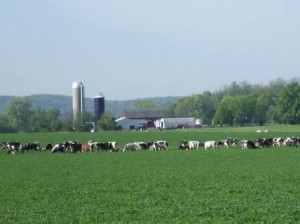June 19, 2014
 A Thought Leader Series Piece
A Thought Leader Series Piece
By Dr. Anthony Michaels
Note: Dr. Anthony Michaels (Tony) is an internationally known environmental scientist who has been a leader in both academia and business. On May 15, 2014, Dr. Michaels became CEO of Midwestern BioAg, the industry leader in biological agriculture and one of the pioneers in sustainable food production.
Can We Feed Nine Billion People While Improving the Environment?
As the world population grows to nine billion people, we face many fundamental questions. How can we improve agricultural production to feed that many people? How can we improve farm economics? How can we reduce climate impacts, minimize the nitrogen runoff that creates dead zones in oceans and reverse soil erosion? How can we create nutrient-rich foods? I believe that a big part of the answer is biological agriculture.
Biological agriculture is an integrated farming system. It combines the best historical practices, honed over centuries, with the strength of the latest scientific discoveries. It promotes natural biological processes to dramatically improve agricultural yields and reduce farm costs.
I first became aware of biological agriculture when I was an advisor to my uncle, Gary Zimmer, who is considered the father of biological agriculture. He founded Midwestern BioAg (“MBA”) over 30 years ago. He and his company have taught farmers how to improve the soil life, mineral balance, and the soil structure of agricultural lands. Now biological agriculture is used on thousands of farms on three continents with remarkable results.
The Limits of the Green Revolution and Organic Farming
The “Green Revolution” of the middle of the twentieth century consisted of improvements to crop genetics; biotechnology; expansion of irrigation infrastructure; the widespread use of synthetic fertilizers, herbicides and pesticides; and improvements in farm management practices. These are credited with more than doubling crop yields.
We now realize that these improvements came at a cost. Conventional chemical agriculture now dominates the agricultural landscape in the developed world. It relies too heavily on mono-cropping a few major crops, fossil-fuel-based fertilizers, and intense use of chemicals for crop protection. Not only are these methods, when used in excess, expensive and damaging to the environment, but they also damage microbial soil life – thus limiting long-term soil fertility and the services that biology can provide.
Organic farming is inherently biological, and has been seen as the counter-point to conventional agriculture. However, it also has its limits. Most organic farming is defined by what it “doesn’t” use – synthetic inputs. With extensive prohibitions on materials beyond the obvious pesticides, herbicides, fungicides and synthetic nutrients, the toolkit is more limited.
 A good organic farmer has to be exceptionally well skilled to outperform conventional farming practices with that limited toolkit. It is hard to envision that we can meet the challenge of training that many farmers worldwide to the level necessary to feed nine billion people through organic farming. Furthermore, not all soils and not all cropping systems are suited to organic production. In some farming systems, there are no “natural” responses to the pests, weeds and diseases that attack certain crops.
A good organic farmer has to be exceptionally well skilled to outperform conventional farming practices with that limited toolkit. It is hard to envision that we can meet the challenge of training that many farmers worldwide to the level necessary to feed nine billion people through organic farming. Furthermore, not all soils and not all cropping systems are suited to organic production. In some farming systems, there are no “natural” responses to the pests, weeds and diseases that attack certain crops.
Biological farming is intermediate between conventional and organic, not as a compromise, but as a thoughtful systems approach. Biological farmers search for ways to have the farm biology and ecosystem provide services for free that the farmer would otherwise pay for through the use of chemistry or farm equipment.
Biological farming has the option of using the full toolkits of biological and chemical farming, but in moderation and with a preference for reduced reliance on chemicals and soluble fertilizers across the whole system. It takes more thought than chemical farming, but with access to the full range of tools, it is a much easier way to realize the full value that biology can bring to a farm.
Biological Agriculture Works with Nature
Our understanding of soil microbiology has increased by leaps and bounds over the past two decades. We now understand that microbial organisms in healthy soils (bacteria, fungi, protists, metazoans) have symbiotic relationships with plants and play a vital role in nutrient uptake that optimizes the health and growth of plants.
How does biological agriculture work? First, biological farmers test and then balance their soil by applying a wide range of minerals, beyond the standard nitrogen, phosphorus, and potassium of traditional fertilizers. Moreover, they use mineral forms and carbon-mineral formulations that are less damaging to soil life and less likely to leach or run off into watersheds.
Next, biological farmers feed microbial soil life by using carbon from compost, green manures, livestock manures and crop residues. They choose crop rotations and cover crops that increase biodiversity and fix atmospheric nitrogen, providing a free alternative to the most carbon-intensive input for chemical agriculture. They apply pesticides and herbicides responsibly and only when necessary; we have found that improvements in trace mineral availability and soil life dramatically reduce or eliminate the need for pesticides and fungicides. Finally, biological farmers use limited tillage practices that preserve healthy soil structure while incorporating carbon from crop residues and cover crops back into the soil.
The end result is a diverse, healthy ecosystem that produces higher yields at lower costs. And, because biological farmers work with nature instead of fighting it, the environmental benefits are enormous: substantial reduction in carbon footprint, increased drought resistance and improved water usage, reduction or elimination of nutrient runoff, and rebuilding of soils to counter-act erosion. The human health benefits are also substantial because fully-mineralized, biologically-grown plants incorporate more nutrients into the crops and have little or no residues from the crop-protection chemicals.
Anaerobic Digesters Can Reduce the Carbon Footprint of Agriculture
Another elegant innovation is the use of anaerobic digesters that process animal manures, not only to produce clean energy, but also to produce a nutrient-rich, carbon-based fertilizer from the waste. Midwestern BioAg focuses on maximizing the nutrient value of the solids that remain after the digester creates biogas or electricity. These solids are then dried, mixed with specialty minerals and granulated to create high-value biological fertilizers. This approach creates a distributed manufacturing system for biological fertilizers that is closer to the end user, requires little shipping, reduces methane emissions and can be customized for any soil or crop.
Arizona State University’s Important Research Focus
Midwestern BioAg is working with ASU on several projects that will advance our understanding of biological farming. Scientists from the Julie Ann Wrigley Global Institute on Sustainability can help understand the full system dynamics as well as determine the carbon life cycle of biological farming compared to conventional or organic farming.
The experts at the Swette Center for Environmental Biotechnology are working to understand the dynamics of soil microbiology and can help tweak the microbes in digesters to maximize the value of the solids as a fertilizer. ASU’s interdisciplinary expertise in microbiology, geobiology, and carbon life cycle analysis makes it the perfect partner for these projects.
We Can Feed Nine Billion People and Improve the Environment
With all the recent breakthroughs in soil microbiology, we know we can substantially increase agricultural production through biological farming systems. Biological farms already achieve incredible yields – the U.S. records for corn yield (440-452 bushels/acre) are from farms that use the biological approach. Biological farms are also more profitable, a key requirement for any method that is going to be successful.
I believe that this is the future of farming and food production – in fact, I believe it so much that I have left my previous jobs and dedicated my full efforts to building Midwestern BioAg and ensuring that the value of biological farming spreads widely. Bringing biological farming into the mainstream and changing agriculture as we know it – this is a challenge worthy of all of us.
Dr. Anthony Michaels (Tony) is an internationally known biologist and oceanographer and a member of the Board of Directors for Sustainability at ASU. Dr. Michaels has extensive experience in environmental science, oceanography, sustainable agriculture, food security, aquaculture, bio-energy, zero-waste and energy efficiency. He has held a variety of leadership positions in academia and business including as Director of the USC Wrigley Institute for Environmental Studies, Chair of the Council of Environmental Deans and Directors (a network of 160 universities), National Council for Science and the Environment, the Catalina Island Conservancy and the NSF Advisory Committee on Environmental Research and Education. Past business positions include roles as Managing Director of Proteus Environmental Technologies, Chief Scientist at Pegasus Capital Advisors, President of MPH Energy and CEO of PhycoSystems. On May 15, 2014, he became CEO of Midwestern BioAg.

